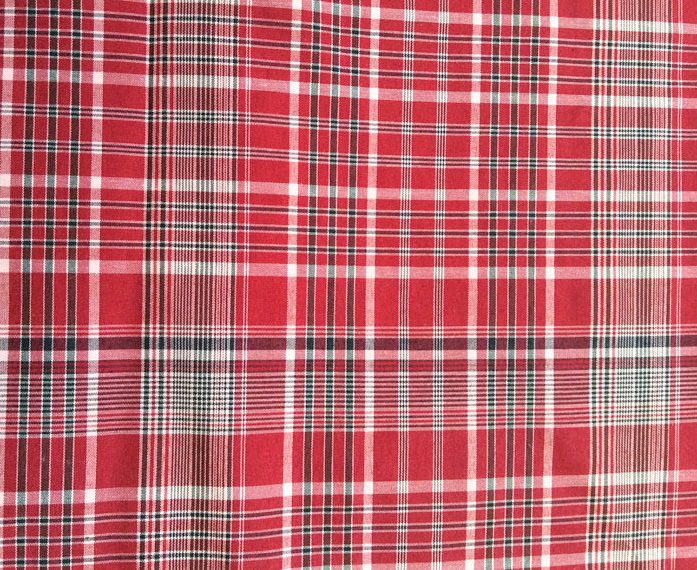For people with an artistic bent, sampling local crafts is an essential for travel. And in Jamaica, that means calico cloth. Also, the fabric is beautiful. It’s useful. And it’s a staple of traditional dress for men and women. Also, it has many other uses. If you’re traveling to Jamaica, a nice piece of calico cloth will also make a unique souvenir, for you, or for the artist in your life.
Calico: Definition
Related: Traditional Jamaican Clothing
Calico originated in India. The name comes from Calicut, or Calcutta. The British brought calico cloth to Jamaica in the seventeenth century, and people there quickly incorporated it into their everyday dress. Calico cloth is a plain-woven fabric made from unbleached and semi unprocessed cotton. It’s not as fine as muslin, but not as coarse as either canvas or denim.
Because calico cloth is essentially unfinished, you can often see flecks of cotton seeds in the fabric. Undyed calico tends to have a cream or grey colored finish, making it the perfect base for dyeing or printing. Calico is created using a ‘plain’ weave which sees the lengthwise yarns (the weft) passing over and under the crosswise yarns (the warp), alternating each row.
It’s a very versatile and useful fabric. The fact that it wears well and is inexpensive made it popular around the world. In addition, the fact that it is light and breathable makes it ideal for island climates. Traditionally, Jamaican calico is dyed lovely colors. Plaids are popular.
In the United States, calico is popular in quilting and dressmaking. As a result, it will probably look very familiar to you.
Calico Cloth in Traditional Jamaican Dress
When describing traditional Jamaican clothing, several words spring to mind. First, comfort. Jamaica has a tropical climate. It is often warm and humid. For this reason, clothes need to be light and breathable, while still protecting the skin from sunlight. Second, modesty. Modesty was a part of the cultures of the island before colonization. However, the influence of the English invaders cemented modesty as a part of the national dress. Finally, flamboyant. The culture is vibrant and colorful, and people’s clothing tends to be as well.
Traditional male dress includes either long or short trousers and short sleeved shirts. Red, gold and green, the colors of the Ethiopian flag, are popular. As are tams, or knit caps. Traditional Jamaican women’s dress includes tiered quadrille or “bandana” skirts and colorful headscarves made of calico.
THE HISTORY OF JAMAICAN BANDANABandana cloth originated in far off Chennai, in Eastern India. However this light,…
Posted by Jamaica Information Service on Tuesday, August 4, 2015
Wait… Bandanas?
In the United States, people wear bandanas as headgear, or as a neckerchief, to catch sweat or keep the sun off. But the word and the concept goes back a lot longer than that. Like calico cloth, the bandana has its origins in India. The word ‘bandana’ means “to tie” in Hindi. The paisley pattern that we usually associate with the modern bandana, came from Glasgow. Traditional Jamaican bandana cloth is plaid.
In Jamaica, the calico cloth is used for dresses, as well as traditional headscarves. And ‘bandana cloth’ is another name for calico.
The Quadrille Dress
The Quadrille Dress is the women’s folk costume of Jamaica, Haiti, and Dominica. Other names include Kwadril, Bandana dress, and Karabela. The Quadrille dress consists of a long, multi-tiered skirt made from calico cloth, and paired with a ruffled top and matching head scarf. Traditional colors include a combination of red, white, and maroon. This is typically the costume Quadrille dancers wear during performances. The Quadrille dress represents clothing from the 18th century. It is a performance costume, rather than everyday wear.
Other Uses for Calico Cloth
In the United States, calico is popular for quilting and clothing manufacture. It’s also popular for handbag design and for use in household items. Also, dressmakers and designers use undyed calico to create mock-ups of garments before making them with more expensive fabric.
Manufacture and Sale of Calicos
Much of the calico fabric in Jamaica is handmade in Jamaica. And this makes it special. Also, once you find a calico you like, there are numerous designers, tailors, and dressmakers who will be happy to turn it into a one of a kind garment.
Finding just the right place to buy it, however, might require a little footwork. You can start with some of these listings from the Caribbean Yellow Pages.
Where to Buy Authentic Jamaican Calico in the United States
You don’t have to go all the way to Jamaica to find authentic calico cloth. You can support small business by purchasing Jamaican fabric from individual sellers on Etsy and Ebay. In addition, your local fabric store may also be able to special order Jamaican fabric at your request.
Conclusions
Calico cloth has been popular for centuries, all over the word, and with good reason. It’s light yet durable. In addition, it’s inexpensive. It also takes dye and printing well. If you’re traveling to Jamaica, a length of locally made calico cloth is a piece of history brought into the modern world. And it’s a souvenir that you can craft into something beautiful, useful, and unique.
Featured Image courtesy of JamaicaStores on Etsy.

